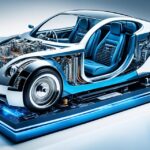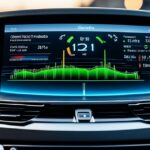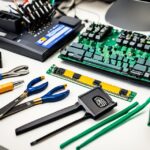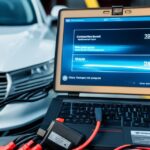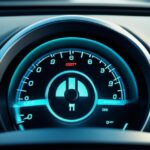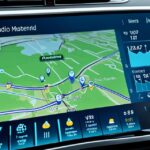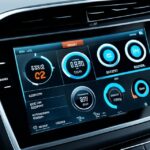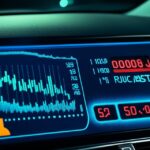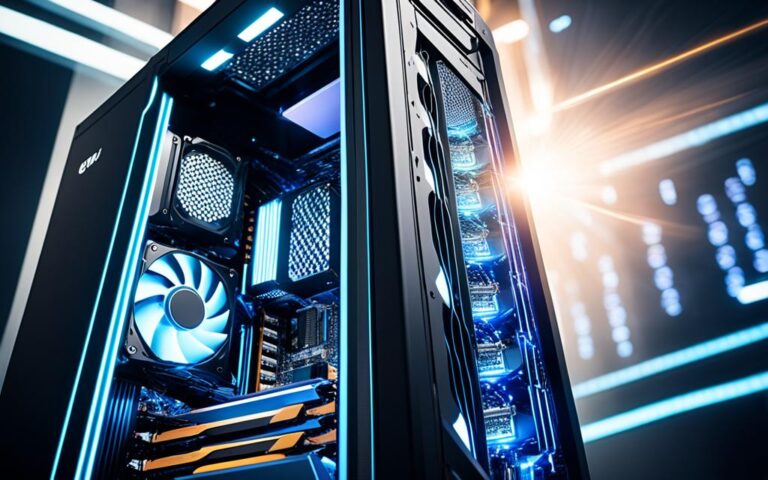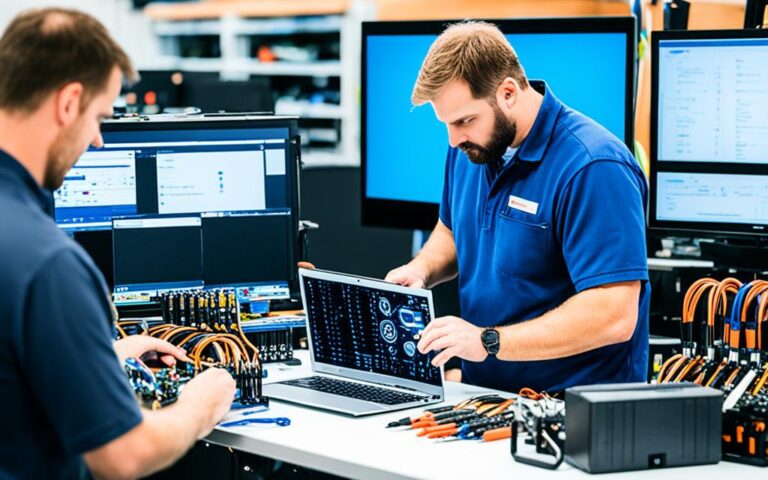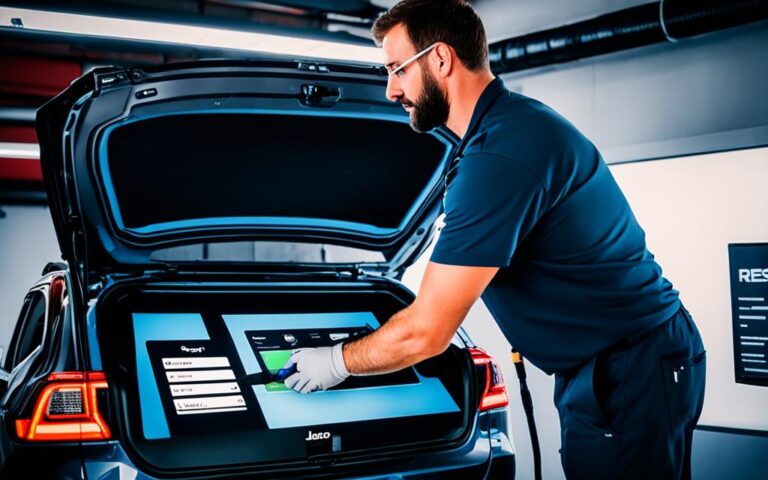Car lovers and online forums highlight certain vehicles known for their reliability and the absence of computer systems. Among these, old VW diesel and Toyota pickups stand out. They’re loved for their simplicity, long-lasting nature, and the chance to customize them.
Many car fans like that these vehicles don’t need complex electronics. They use mechanical parts that are easy to fix. This means owners can handle repairs themselves, without the hassle of computer troubles.
These cars open up new possibilities for those who enjoy fixing things themselves or love vintage cars. They let owners make their cars truly their own. This makes each car stand out on the road.
Key Takeaways:
- Old VW diesel and Toyota pickups are known for being reliable and having no computer systems.
- These cars offer simplicity, durability, and the chance to customize them.
- Owners value the easy upkeep and the ability to fix these cars by themselves.
- Cars without computer systems provide a unique and personalized driving experience.
Finding Easy-to-Maintain Cars with No Computers
If you’re on the hunt for easy-to-maintain cars without computer systems, you have several choices. The classic Volkswagen Beetle is a top pick for its simplicity and dependability. Cars from the 1960s, especially those from the US, are also great picks since they often skip onboard computers1. Vehicles from the 1970s and earlier are even simpler, with fewer electronics, especially those with carburetors1. For newer options, some Mercedes-Benz diesel models from the early 1980s were built without complex electronics, making them interesting choices1.
When looking for cars without computer parts, think about a few things. The models you can find might depend on where you live and what you like. But remember, older cars might not have the latest electronics, they could have lead-based paint or use lower-quality parts1. So, it’s smart to research well before buying.
“Longitudinally mounted 4-cylinder engines with rear-wheel-drive setups and minimal options are often easier to maintain and repair than newer models with more electronics,” a commenter mentioned1.
For those wanting fun-to-drive cars with no computers, check out entry-level models from brands like Honda, Toyota, Mazda, and Hyundai. These brands are known for their straightforward yet dependable cars1. Cars from these European brands are seen as having fewer electronics, making them great for those who prefer a simpler drive1.
It’s also true that low-end North American cars might not be as reliable and often have more advanced features like better brakes or remote door openers. This might not be what you’re looking for if you want a car without computer parts1. But, if you want a car that’s easy to handle and doesn’t break the bank, the Toyota Yaris and the base model Honda Civic coupe are great picks1.
| Brand | Model | Recommended For |
|---|---|---|
| Honda | Civic coupe | Simple driving experience |
| Toyota | Yaris | Simple driving experience |
| Mazda | [Model Name] | Simple driving experience |
| Hyundai | [Model Name] | Simple driving experience |
The Evolution of Car Computers
Car computers have changed the automotive industry a lot. They’ve made vehicles work better and perform more efficiently. The first step was the use of electronic fuel injection systems, which brought computers into cars. This made fuel use better and improved how cars worked.
In 1968, the Volkswagen Type III was the first car with an engine computer, the Bosch D-Jetronic EFI system2. This was a big step forward for car technology. By 1990, every car made in the West had a computer2. This showed how important car computers had become.
Car computers led to the use of fuel injection systems. Before, cars used carburetors, which weren’t as efficient. Fuel injection systems are better at controlling fuel and air, making cars more efficient and cleaner2.
A key part of modern cars is the Powertrain Control Module (PCM). It talks to sensors and adjusts things like fuel injectors and spark plugs for better performance2. The PCM is very advanced, with a fast processor and uses less memory2. It can learn and change settings for a smoother drive2.
Car computers have made cars better and more efficient. They use electronic fuel injection and advanced technology to improve driving and meet environmental rules.
The On-Board Diagnostics Requirement
As car computers got better, the need for standard diagnostic systems grew. In 1991, On-Board Diagnostics (OBD) became a must for all cars3. OBD made fixing car problems easier and more standard.
Before OBD, some cars didn’t even have computers3. These cars were simpler and easier to fix. But as computers became more common, fixing cars got harder3.
The 1980s saw the start of electronic carburetors and fuel injection systems3. This changed how cars were maintained. Electronic ignition systems were more reliable, but fuel injection systems were complex3. Still, fuel injection was a big step forward, replacing old carburetors that were bad for the environment3.
By 1981, people looking for cars without computers aimed for those made in 1974 or earlier3. Some American cars from the early 80s or older didn’t have computer chips3. VW diesel cars made until 1992 also didn’t have computers, except for some basic parts3.
This change in car computers shows how cars have become more advanced. They now use electronic ignition and timing control modules4. The move to computer controls and away from carburetors shows the industry’s focus on better performance and the environment4.
| Evolution of Car Computers | Statistical Data Reference |
|---|---|
| The first car with an engine computer introduced in 1968 | 2 |
| By 1990, every car produced in the West was equipped with computers | 2 |
| The last recorded vehicle to run on a carburetor instead of a computer – 1991 Oldsmobile Custom Cruiser | 2 |
| The rise of fuel injection systems and the phase-out of carburetors | 2 |
| The capabilities and components of a modern Powertrain Control Module (PCM) | 2 |
| The implementation of On-Board Diagnostics (OBD) starting in 1991 | 3 |
| Cars without onboard computers and simpler engine setups | 3 |
| The integration of electronic ignition systems and timing control modules | 4 |
| Cars from specific time periods considered devoid of computer chips | 34, |
Simple Cars to Work On from the 1970s and Earlier
Working on cars is easier with simple designs. Cars from the 1970s and earlier, without complex computer systems, are great for DIY fans. We’ll look at some easy-to-maintain cars from that time.
The Chevy Nova II and the Dodge Dart from 1972 or earlier are great for beginners. They have easy-to-reach engine areas, making repairs straightforward. Without modern engine systems, maintenance is simpler5.
Older pickups, especially those with straight 6 engines, are popular among DIY enthusiasts. They have big engine compartments, making it easy to work on parts like carburetors. Their simple mechanics make them a joy to fix5.
The VW Beetle is another great choice for those wanting a simple car. Models from 1973 or 1974 are easy to maintain. They have basic systems, making them simpler than newer models5.
These cars offer lots of space and simple mechanics for easy upkeep. With basic tools and an owner’s manual, you can do many repairs at home. For tougher jobs, you can find special kits for classic car parts5.
The Appeal of Simple Classics
Let’s look at some popular 1970s classics that are simple and affordable. Classics like the Fiat 500 and 600 were big hits back then. The Fiat 500 was priced around £5000, making it a great choice for those wanting a basic car6.
The Triumph Spitfire is another great option for budget-conscious buyers. With prices starting at £2000, it’s a great deal for classic car lovers6.
In the 1980s, the BMW 3 Series E30 became popular as a starter classic. These models were easy to maintain and had fixed rust issues. They offered a good balance of maintenance ease and performance6.
The Humber Sceptre from 1963-1967 is another stylish choice. It’s a Rootes car known for its elegance and can be found starting at £50006.
The Volkswagen Beetle from 1970-1977 is also a great pick. It’s faster and easier to handle than earlier models. Prices are reasonable, making it an attractive option for classic car fans6.
EMP Resistance and Affordability
Older cars from the 1970s are also great for EMP resistance. Data shows they can withstand EMP tests without damage. This makes them a smart choice for EMP protection7.
Modern cars with solid-state electronics could be damaged by EMP. They might not start without an engine computer7.
Carbureted engines and basic wiring make these older cars less vulnerable to EMP. They’re practical and affordable for EMP protection7.
Some EMP-resistant cars you can get for under $2,000 include the Volkswagen Beetle and Dune Buggies. These vehicles are affordable and offer EMP protection7.
The pre-1980 Chevrolet Cheyenne and the Land Rover TUM/TUL can be found for under $2,000. This makes them great options for those looking for EMP safety7.
The Volkswagen Beetle is another classic that’s cheap and easy to fix. You can get it for under $2,000 with minimal work. Post-1971 models are even cheaper, offering more affordable choices7.
These simple cars from the past are not just affordable but also offer EMP protection. They combine retro charm, easy maintenance, and EMP resistance for enthusiasts and practical drivers7.
The Benefits and Drawbacks of Computerized Cars
Older cars without computers are simple and easy to maintain. But, modern computerized cars have their own pros and cons. These cars rely on computer systems for better performance, efficiency, and to control emissions. Yet, these systems can be complex, making DIY repairs tricky.
Computerized cars improve how well vehicles perform. They help save fuel, which is good for the environment and your wallet. These cars also have features like anti-lock brakes and stability control, making driving safer.
These cars make fixing problems easier with their onboard computers. They can spot and fix issues fast, saving time and money. Mechanics get detailed info to make repairs quicker and more precise.
Computerized cars also make driving nicer with features like GPS and entertainment systems. You get updates on traffic, music, and can talk on your phone without taking your hands off the wheel. This makes driving more fun.
But, there are downsides to these electronic systems. There’s a risk of your car’s data being shared or stolen. Some car brands share customer data with others, which could be a privacy issue. 28
Fixing these cars can be expensive, especially if they have advanced tech. Repairing these cars might cost three times more than older models. They need special tools and knowledge, adding to the cost. Some owners have had trouble with features like tricky door handles and infotainment systems8.
Too much reliance on these systems might make drivers less alert, increasing the risk of accidents. Looking away from the road too long can lead to crashes. Plus, more driving with self-driving tech could be a problem. 39
| Benefits of Car Computers | Drawbacks of Electronic Systems | Reliability of Computerized Vehicles | |
|---|---|---|---|
| Improved Performance | Reduced Fuel Consumption | Higher Repair Costs | Advanced Safety Features |
| Enhanced Diagnostics | Convenient Features (GPS, entertainment) | Data Privacy and Security Concerns | Disengagement of Human Drivers |
Computerized cars have many advantages, like better performance and easier fixes. But, we must think about the downsides, like privacy worries and higher repair bills. Finding a balance is key when deciding on these cars, ensuring they’re safe and reliable for drivers.
Exploring Alternative Options: Arduino-Powered Cars
For those who love tech and want something unique, some hackers suggest swapping a car’s computers with Arduino chips. Arduino chips are like mini-computers you can change to fit different needs. Using Arduino in a car makes it hard to hack remotely. But, it would need a lot of car modders to make Arduinos that fit different car systems10.
Modifying a car with Arduino opens up new possibilities for car lovers. It lets them be creative and make their cars better. By using Arduinos, car owners can make their cars secure and unique. Arduino cars are a safe and flexible choice compared to traditional ones10.
Advantages of Arduino-Powered Cars
Arduino car mods are great because they use easy-to-find parts. This is different from old methods that needed rare parts. It makes it simpler for car fans to get what they need for their projects10.
These cars also offer a chance to learn a lot. The “Arduino Car Projects” course teaches important skills through fun projects. It helps learners get better as they go through the course10.
Creating Arduino-Powered Cars
To make an Arduino-powered car, you need certain parts and to know how to put them together. You’ll need things like the Crowduino UNO, Crowtail-Motor base shield, and a USB camera11. You also need a 4WD Utility Car, Pan-Tilt, and a battery with a holder11. Then, you follow steps to prepare the car’s body, brain, power, and eyes, and test it later11.
To add WIFI video, connect a camera to the WIFI module. Link the Pan-Tilt to the Crowtail-Motor Base Shield for camera movement11. The guide also shows how to upload code, install an app, and connect to the car’s WIFI11. This guide helps enthusiasts build and use their Arduino cars, improving their skills.
Expanding Arduino-Powered Cars
Arduino car mods can be taken further. You can make a car that avoids obstacles with ultrasonic sensors or one that tracks with IR sensors11. This lets car fans customize their cars more and try out new things.
The Arduino community is full of ideas for more complex projects. You can build robotic arms or mecanum wheel robots with stepper motors12. This gives enthusiasts the chance to make their Arduino cars unique and impressive.
| Advantages of Arduino-Powered Cars | Creating Arduino-Powered Cars | Expanding Arduino-Powered Cars |
|---|---|---|
| – Accessible hardware components10 | – Materials needed for assembly11 | – Endless possibilities for expansion11 – Inspiration from advanced projects in the Arduino community12 |
| – Comprehensive learning opportunities10 | – Step-by-step assembly process11 |
Autonomous Cars and Potential Risks
Autonomous driving is a big step forward, but it comes with risks. Cars without computers are less likely to face these risks. Yet, cars with computers, like self-driving cars, are more at risk. They depend a lot on computer systems for safety and efficiency. This makes them open to threats from car hackers and security issues with their computers.
Car computers are part of the IoT, which means they face cyber threats. Companies and experts are working hard to make these systems safer. But, the risks are still there.
Risks Associated with Fully Autonomous Cars
Many people are unsure about self-driving cars. A survey found 44% of U.S. adults think they’re a bad idea. Only 26% see them as good, and 29% are still not sure13. Also, 63% of people don’t want to ride in one if they could, while 37% are open to it13.
Younger adults are more open to self-driving cars, with 47% interested. This is compared to 25% of those over 5013. Men are more interested, with 46% wanting to try them, while 27% of women are13.
Security is a big worry with these cars. 76% think their computer systems could be hacked, which is dangerous13. This could lead to serious safety issues, privacy problems, and even identity theft.
There’s also concern about jobs. 83% think many jobs will be lost with self-driving cars13. This is true for jobs in ride-hailing, taxis, and delivery services.
Autonomous cars might also widen the income gap. 46% think they will make things worse for low-income people13. The cost of these cars might also stop them from being affordable for everyone14.
But, there are also good points. 72% think they will help older people and those with disabilities live more independently13. This could make life easier for many.
Also, 39% believe these cars will reduce traffic accidents, making roads safer13. They could stop accidents caused by human mistakes.
There are still debates about these cars. Experts say they will become more common soon. By 2035, there could be 54 million self-driving cars on the road15. By 2050, every car might have this technology15.
Autonomous cars could change how we travel, reduce accidents, and help more people. But, we need to tackle the risks and improve security. Trust, laws, and new security tech are key to making these cars safe for everyone.
Survival Scenarios and Car Choices
When electronic devices fail, having a reliable car is key. Cars without computers can be a good choice for getting around after an EMP. These cars are tough and can move even when electronics don’t work.
Old diesel engine cars are great for survival. Cars like the Dodge or Plymouth with slant 6 engines are strong and simple. They’re good for emergencies because diesel engines are less likely to stop working without power16.
These cars are less likely to be affected by EMPs because they’re not as electronic. Modern cars have many electronic parts that EMPs can damage. So, choosing simpler cars is a smart move16.
Older cars are also lighter and easier to move after an EMP. They can go over rough ground better than heavier cars. This helps survivors get to important places16.
Choosing the right car for emergencies is important. Talking to others who have been in tough situations can help. Experts in survival also offer good advice on what cars to pick16.
But there are other ways to get around besides cars. Bicycles are a good choice for survival. They’re easy to fix, don’t need much fuel, and can go on different paths. There are many types of bikes for different places17.
Other ways to move include skateboards, scooters, and skis. Each has its own benefits and downsides. People can pick what works best for them17.
Using animals as transport is another option. Horses can be a good choice but need a lot of food and water. But, you must know how to take care of them and watch out for dangers18.
In summary, picking the right vehicle is key in survival situations. Cars with diesel engines and bikes are good choices. Think about how cars might be affected by EMPs and what you can do yourself. Advice from others and your own skills will help you make the best choice161718.
Conclusion
Cars without computer systems are simple and easy to maintain. But, the car industry is always changing with new technology. In 1969, there were 53,543 vehicle fatalities in the United States, with a rate of 5.04 fatalities per 100 million miles driven19. By 2016, this number went down to 37,461, making the roads safer.
Today’s cars are more reliable and have many new features. They come with power steering, ABS brakes, and better fuel efficiency19. Now, cars also connect with smartphones and offer music streaming, making driving more fun19.
Older cars, without complex electronics, still capture our interest. They let DIY mechanics and fans customize their cars easily. But, modern cars are designed to be more aerodynamic because of fuel economy laws19.
In the future, driverless cars will change how we travel. Companies like Volvo and Google are investing in them20. These cars could make driving safer and more efficient20.
Also, electric cars are becoming more popular, thanks to Elon Musk and Tesla Motors20. They aim for a greener future for cars20.
The future of cars will keep changing, with more technology making cars better. Yet, the simple charm of cars without computers will always be loved by car fans. They offer a unique way to fix and customize cars21.
FAQ
What are cars without computer systems?
These are vehicles that don’t use electronic parts or computer controls for their functions.
Which cars are known for not having computer systems?
Some cars without computer systems include old VW diesel or Toyota pickups, and old VW Beetles. Also, domestic cars/trucks from the 1960s and certain Mercedes-Benz diesel models from the early 1980s.
Are cars without computer systems easy to maintain?
Yes, they are easier to maintain. They have simpler mechanics that DIY mechanics can understand and fix.
What are the benefits of cars without computer systems?
These cars are simpler to maintain and repair. Owners can customize and restore them, giving a sense of control and pride.
Can cars without computer systems offer advanced features?
No, they don’t have the advanced features of modern cars. This includes better performance, efficiency, and emissions control.
Can modern cars be modified to remove the computer systems?
Yes, you can replace a car’s computer with Arduino chips. But, it needs expertise and a deep understanding of the car’s systems.
Are fully autonomous cars vulnerable to hacking?
Yes, they are at risk of hacking because they rely on complex computer systems. Car manufacturers and cybersecurity experts are working hard to make them safer.
Can cars without computer systems be suitable for survival scenarios?
Yes, some old cars like Dodge or Plymouth models with slant 6 engines are good choices. They work well when electronics fail.
What is the future of cars without computer systems?
Cars with computer systems are becoming more common, offering better features and performance. Yet, there’s still a place for older cars without complex electronics. DIY mechanics and enthusiasts can enjoy working on and personalizing these vehicles.
Source Links
- https://community.cartalk.com/t/simplest-car-w-fewest-gadgets/8242 – Simplest car w/ fewest gadgets?
- https://www.carparts.com/blog/when-were-vehicles-first-equipped-with-computers/ – When Were Vehicles First Equipped with Computers? – In The Garage with CarParts.com
- https://community.cartalk.com/t/car-models-without-computer-parts/3211 – Car models without computer parts
- https://community.cartalk.com/t/non-computer-aided-cars/49033 – Non-Computer aided Cars
- https://grassrootsmotorsports.com/forum/tech-tips/how-to-live-happily-ever-after-with-your-pre-obd-classic-car/184681/page1/ – How to live happily ever after with your pre-OBD classic car.
- http://www.classicandsportscar.com/features/starter-classics-14-great-cars-first-timer – Starter classics: the best first classic car to buy
- https://www.askaprepper.com/7-emp-proof-cars-under-2000/ – 7 Emp-proof Cars That You Can Buy For Less Than $2000
- https://www.scientificamerican.com/article/high-tech-cars-might-be-more-trouble-than-theyre-worth/ – High-Tech Cars Might Be More Trouble Than They’re Worth
- https://theweek.com/arts-life/motoring/956478/pros-cons-driverless-cars – Pros and cons of driverless cars
- https://techexplorations.com/blog/arduino/arduino-car-projects – New course: Arduino Car Projects
- https://www.instructables.com/Smart-WIFI-Video-Car-Arduino-Control-/ – Smart WIFI Video Car( Arduino Control )
- https://howtomechatronics.com/arduino-projects/ – The Best Arduino Projects – Robots, Sensors, RC, CNC and more
- https://www.pewresearch.org/internet/2022/03/17/americans-cautious-about-the-deployment-of-driverless-cars/ – 4. Americans cautious about the deployment of driverless cars
- https://www.brookoverlaw.com/blog/problems-with-self-driving-cars-pros-and-cons/ – The Pros and Cons of Self-Driving Cars: Safer Roads or Tech Risk?
- https://www.trantololaw.com/law-firm-blog/car-accidents/5-dangers-driverless-cars/ – 5 Potential Dangers of Driverless Cars – Trantolo Law
- https://prepperhideout.com/blogs/preparedness-information/top-10-vehicles-to-survive-an-emp-attack-discover-which-cars-are-emp-proof – Top 10 Vehicles to Survive an EMP Attack: Discover Which Cars are EMP
- https://zombie.fandom.com/wiki/Transportation – Transportation
- https://uwk.com/blogs/blog/emp-proof-car – Revealed: Is There Such a Thing as an EMP – proof car?
- https://www.econlib.org/are-cars-much-better-than-50-years-ago/ – Are Cars Much Better than 50 Years Ago? – Econlib
- https://www.theurbanist.org/2016/01/07/the-good-and-the-bad-of-driverless-cars-for-cities/ – The Good and the Bad of Driverless Cars for Cities – The Urbanist
- https://news.ycombinator.com/item?id=29281034 – Ask HN: Best cars without too much digitalization?


